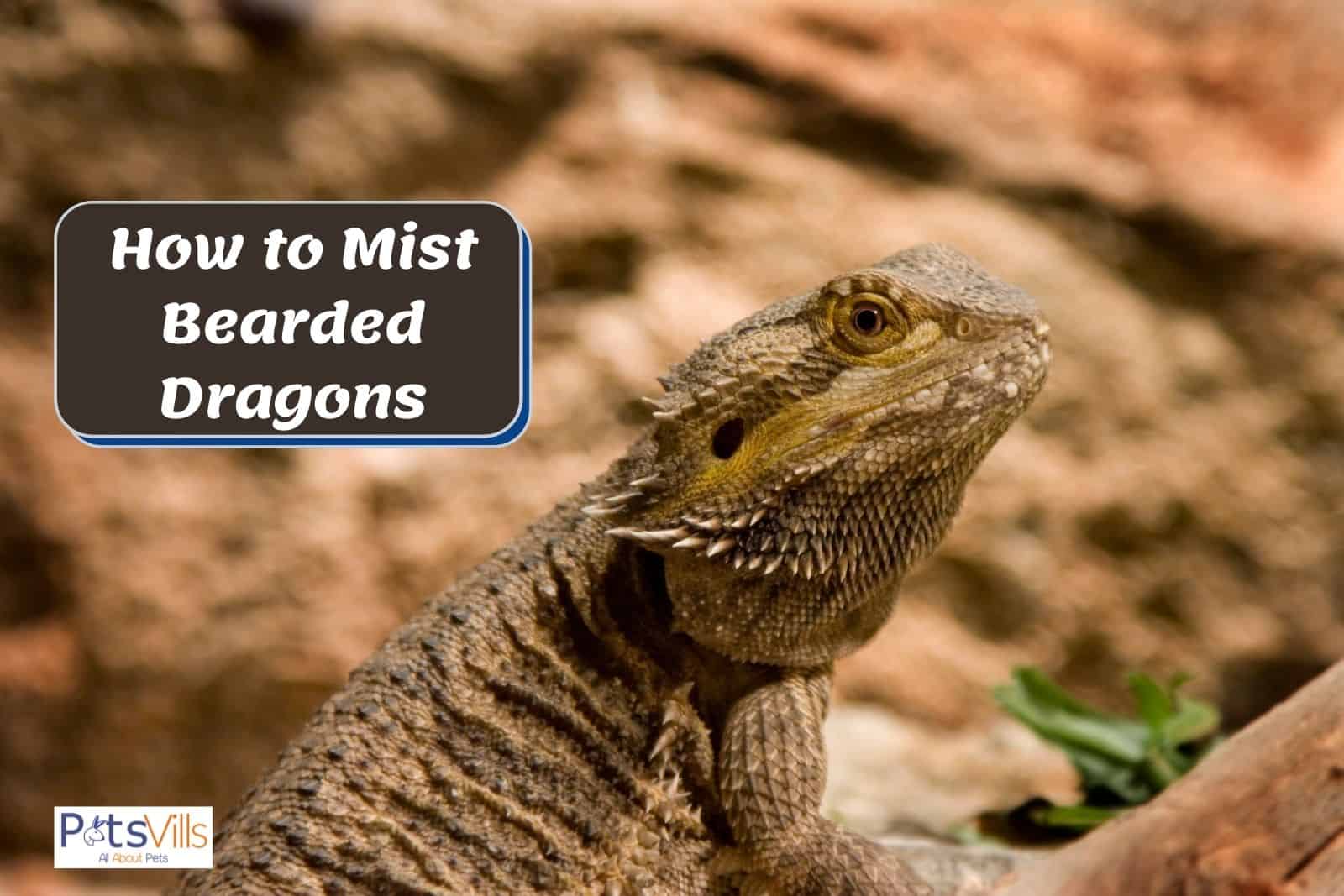Are you wondering how to mist bearded dragons?
As you’re going to learn, misting bearded dragons has its benefits and is something that can help you keep your pet well-hydrated.
So, keep reading to discover why you should mist your pet and how to do it properly.
READ MORE: Do Bearded Dragons Need Water Bowls?
Table of Contents
Do Bearded Dragons Need to be Misted?
If you’re a first-time reptile owner, you’re probably confused when you hear people talking about “misting” bearded lizards. But it’s not something complicated.
Misting refers to the practice of spraying water droplets on a bearded lizard’s head and body to encourage drinking. Misting also refers to spraying your beardie’s enclosure and food.
But do bearded dragons need to be misted and why? Let’s see the three most common reasons why owners spray their bearded lizards with water.
#1 Hydration
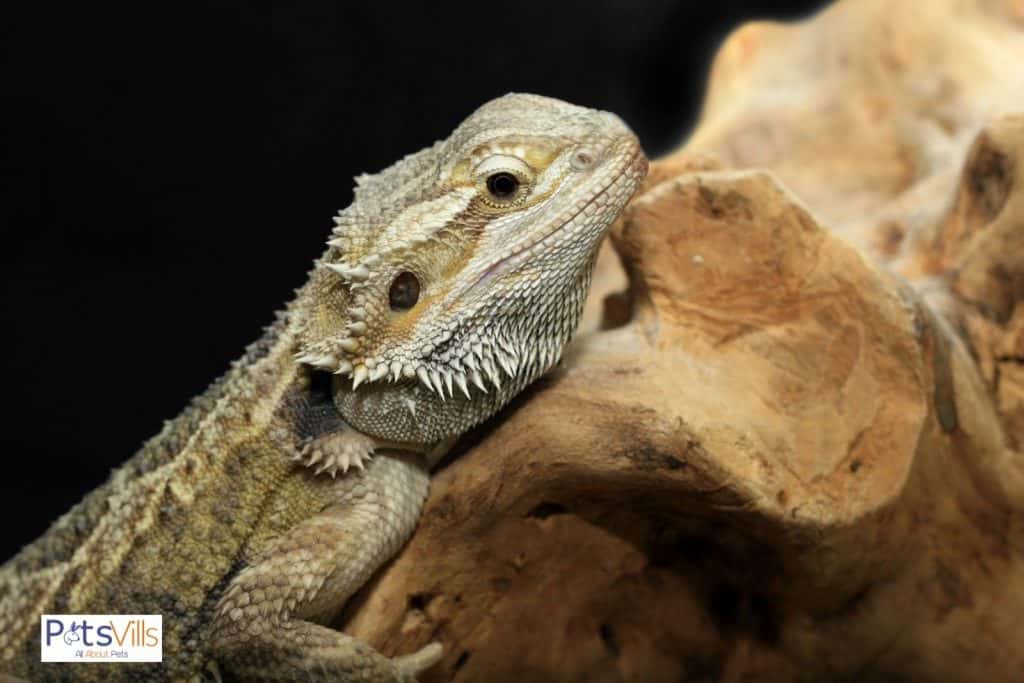
Have you ever seen your bearded lizard drink from a water dish? It’s not a surprise if you haven’t. Most reptiles don’t recognize a bowl as a water source, unlike cats and dogs.
Think about it. Bearded lizards come from the dry climate of Australia, where you’ll rarely stumble upon puddles of water. And there’s no one around to provide bowls of fresh water.
Instead, beardies get hydrated in the wild by licking raindrops from vegetation, eating moisture-rich food, or drinking rainwater that falls over their bodies.
As such, it’s easy for bearded dragons to become dehydrated when raised in captivity. Stagnant water isn’t as appealing to them as moving one, so they ignore the bowl.
That’s why owners often have to get creative. Misting is one of the ways to keep your pet lizard hydrated if they’re not drinking enough or are recovering from dehydration.
By misting your bearded dragon’s body, you mimic rainwater. Most lizards find those falling waterdrops irresistible and start licking them.
However, misting is only effective if your beardie laps the droplets of water rolling down their head. They can’t absorb moisture through their skin, despite what most people believe.
CHECK: What Temp Should a Bearded Dragon Tank Be?
#2 Shedding
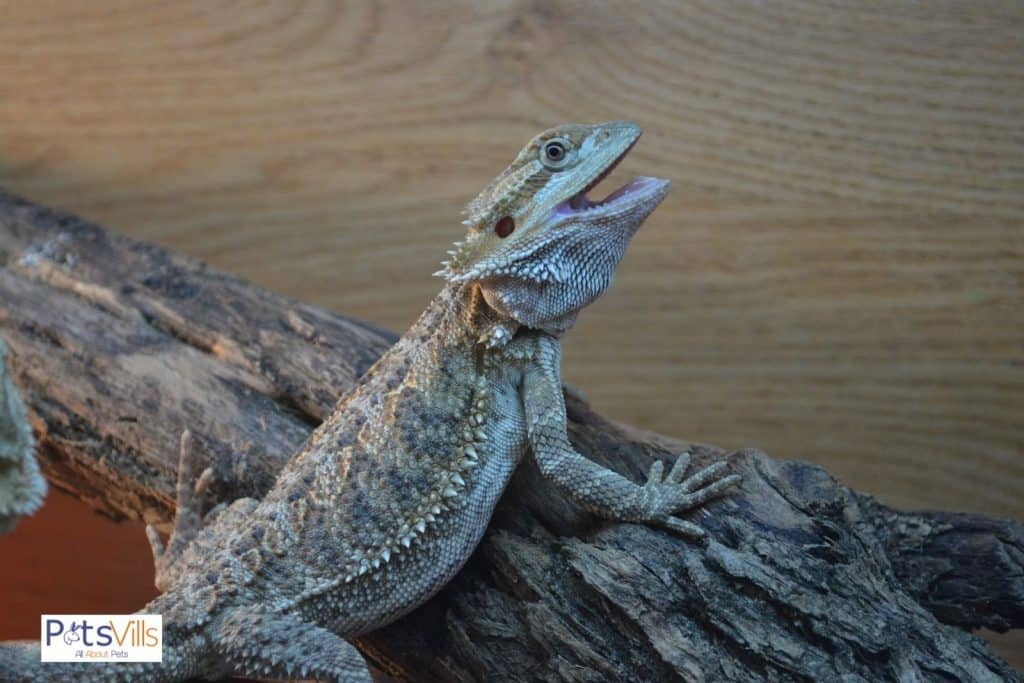
Bearded lizards’ skin is made from keratinized scales. These scales aren’t elastic and won’t stretch as the dragon grows. That’s why baby bearded dragons shed a lot while adults – once or twice a year.
Unfortunately, sometimes the shedding doesn’t go smoothly due to lack of proper hydration, diet, or low humidity.
And that’s terrible news because stuck shed can compromise blood flow, cause infections, and even cell death.
But as specialists from RSVA explain, “Most shedding issues can be corrected with adjustments in
hydration and humidity.” [1]
That’s why it’s a good idea to mist your lizard to encourage proper shedding. Misting helps by increasing the humidity in the tank and softening the stuck scales.
#3 Humidity
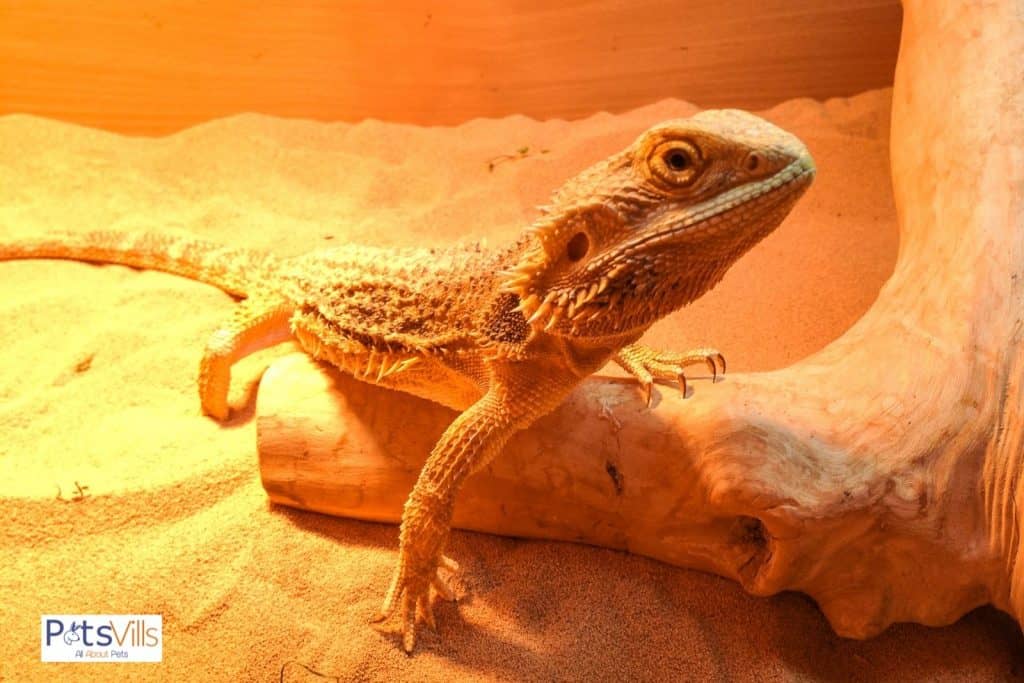
Since beardies come from an arid climate, they’re used to low to moderate humidity levels. In general, specialists recommend keeping the humidity between 30 to 40%.
However, when the humidity levels are too low, your beardie is in danger of femoral pore blockage, kidney problems, and urinary tract infection.
Fortunately, misting the tank is one of the easier ways to deal with low humidity. When water evaporates, it increases the moisture in the air.
So, regular misting can help you maintain the proper humidity environment for your pet when the levels are too low.
However, you should be careful not to mist your dragon and its enclosure too much. High humidity levels cause respiratory issues, bacterial infections, and fungus/mold overgrowth.
Related: How To Lower Humidity in Bearded Dragon Tank?
Is Misting Bearded Dragons Necessary?
You’re going to hear many controversial opinions when it comes to misting bearded dragons.
For example, one beardie owner says, “It doesn’t help any fluid intake and can raise the humidity levels by a great deal.” [2] Another one shares, “They really love it. I mist them every morning.”
There’s no right or wrong answer. It all depends on your bearded dragon’s overall health. So, don’t panic if you’ve never misted your bearded dragon.

If your pet drinks water, eats the right diet, and has regular baths, misting isn’t all that necessary. You can keep an eye on for signs of dehydration and start misting when there’s a problem.
But if your bearded dragon ignores the water dish in their enclosure and hates baths, misting can make all the difference and prevent dehydration.
And as I already said, misting is beneficial for dragons with shedding problems, and it keeps the skin soft.
How to Mist Bearded Dragons in 7 Steps
As you can see, misting has its advantages and can keep your bearded dragon hydrated, speed up the shedding process, and raise the humidity in the tank.
But how to mist a bearded dragon? It’s not that hard as long as you follow these steps.
#1 Get a Spray Bottle
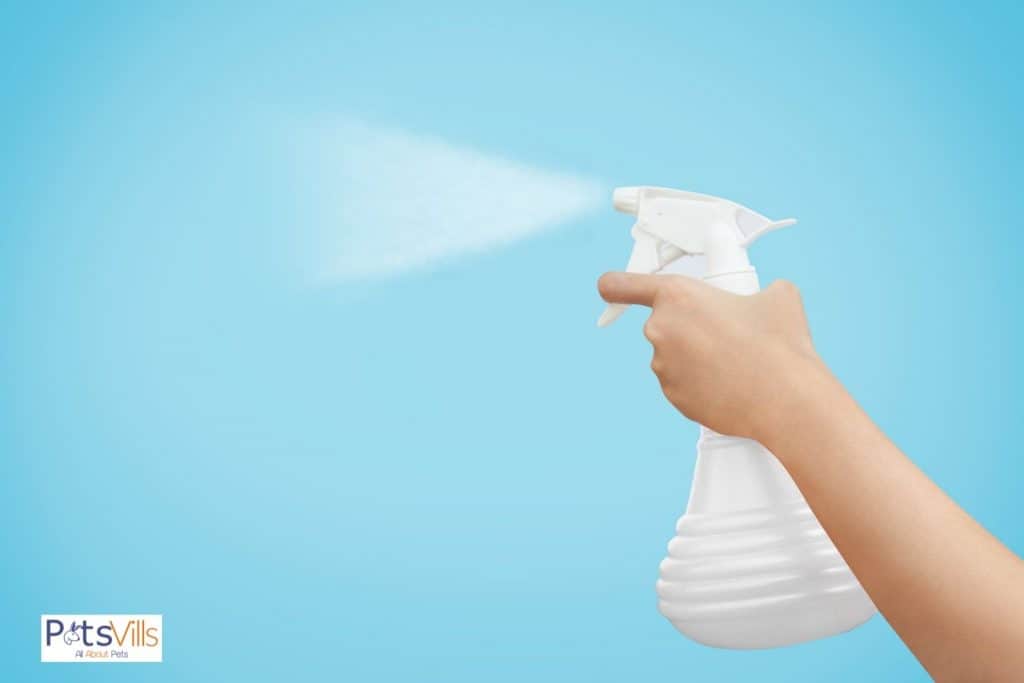
To mist your bearded lizard, you don’t need any special equipment. An ordinary spray bottle will do the trick as long as it sprays a fine mist [3].
But don’t use any spray bottles that contain chemicals or toxins. You can poison your lizard by accident.
If you don’t have a spray bottle available at home, you can buy one designed for reptiles from any pet store.
#2 Fill the Bottle with Water
Never use cold water to mist your bearded lizard. It will shock your pet’s system and wreak havoc on their thermoregulation.
You need to fill the bottle with warm water. Aim for a water temperature around 90-100 degrees Fahrenheit, the same temperature you’ll bathe a baby.
You should use bottled water for the best results because it’s free of any potential chemicals and toxins that can irritate your lizard’s skin.
#3 Adjust the Spray
Before you start misting your bearded dragon, you should check the spray’s strength and adjust it if necessary.
Remember that you need a fine mist to produce the desired water droplets over your bearded dragon’s head. A strong spray can harm your beardie because your pet will inhale the water, which will damage the lungs.
#4 Pick the Right Time to Mist
If you’re misting bearded dragons to hydrate them and deal with shedding problems, you have to pick the right time.
Don’t mist your pet lizards when they’re basking, for example, in the morning or after a meal. The heat from the UV lamp will dry the skin and vaporize the water droplets.
Instead, wait for your bearded dragon to finish basking before you spray them.
#5 Remove your Bearded Dragon from the Enclosure
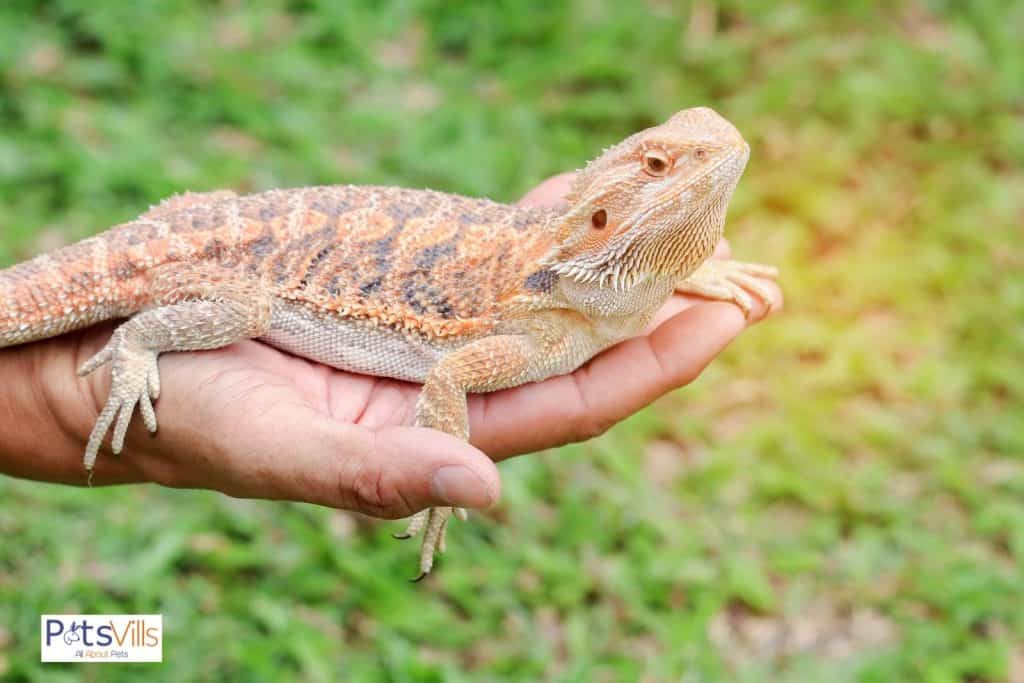
As I already said, missing raises the humidity level in your lizard’s tank. So, it’s a good idea to mist your pet outside its enclosure.
Otherwise, you risk raising the humidity levels in the tank too much, especially if you have live foliage and a water dish inside.
To pick your bearded dragon, follow these steps:
- Approach your pet from the side or front and slide your hand under the body. Don’t just pick them from above.
- Make sure you’re supporting the chest and front legs with one hand and the rear legs and tail with the other.
- Hold firmly but don’t squeeze.
#6 Mist Your Beardie
Once you’ve taken your bearded dragons out of the tank, find a suitable place to mist them – somewhere easy to clean or an area you don’t mind getting wet:
- Pick the spray bottle and mist your bearded dragon’s head until water droplets form.
- Wait for your pet reptile to lick the drops.
- Repeat until your lizard isn’t interested in the water anymore.
- If you’re dealing with a stuck shed, focus your spraying on the area until the skin softens. Don’t pull the stuck pieces because you can tear the new skin underneath.
#7 Return the Bearded Dragon to the Tank
Once you’ve seen your lizard lick the water droplets, you can return your pet to the enclosure. Aim for short misting sessions, or your beardie can get too cold.
Check out this helpful video:
3 Other Ways to Use Misting to Benefit Your Bearded Dragon
Besides misting bearded dragons’ bodies, you can use the spraying bottle in other ways to help your pet lizard stay hydrated.
#1 Food Misting/Plumping
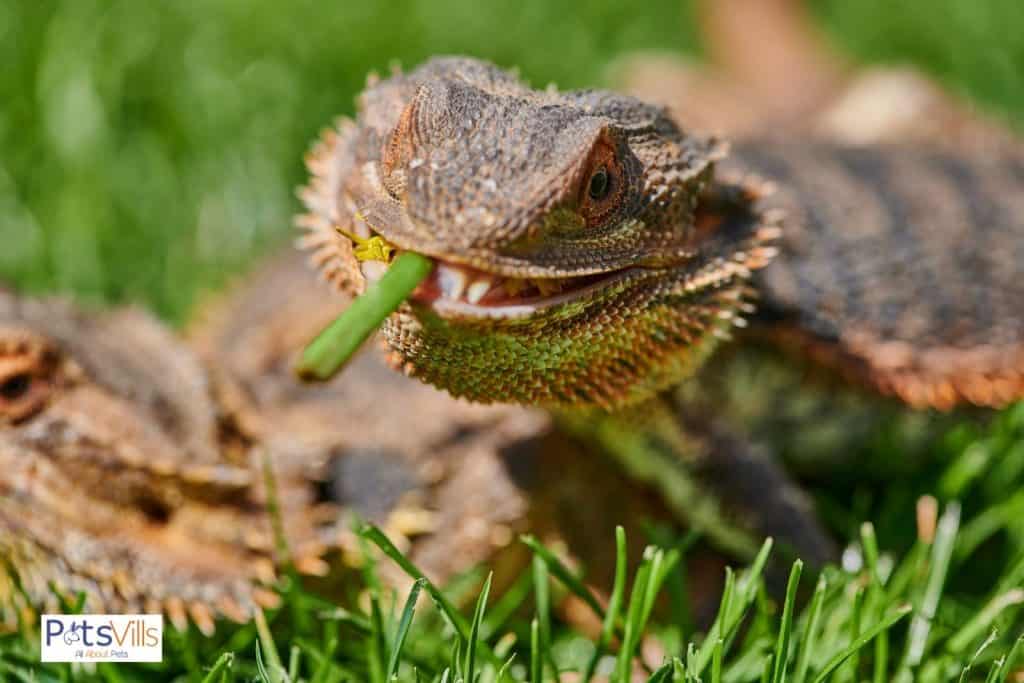
Bearded dragons get most of the water they need through a varied diet of fresh greens and insects in the wild. But in captivity, the food isn’t always as fresh, even if you provide a balanced diet.
So, misting or plumping the food is an excellent way to increase your beardie’s hydration levels. And it’s not something that takes a lot of time:
- Prepare your bearded dragon’s veggies and fruits as usual. Check our Bearded Dragon’s Feeding Guide if you aren’t sure which foods are safe for lizards.
- Spray the dish with water. Use filtered water for the best results.
- Place the bowl inside the tank and re-spray the food once you notice it has gone dry.
However, keep an eye on the humidity levels inside the enclosure. Get a hygrometer to measure the humidity and remove the food dish if the moisture gets too much.
#2 Tank Misting
Do you know that bearded dragons use their tongue to explore their surroundings? As such, misting the glass of the tank is a clever way to get your beardie to drink some extra water:
- Remove your bearded lizard from the tank.
- Use the spraying bottle to mist the glass and keep an eye on the humidity levels.
- Return your lizard to the vivarium and observe if it licks the water drops.
#3 Decor Misting
Besides misting your bearded dragon’s tank, you can also spray the decor items to encourage your lizard to drink more. For example, mist the rocks, plants, and lizard toys.
However, you shouldn’t drench the decor with water. Too much moisture in the tank will lead to respiratory issues and bacterial infections.
How Often Should You Mist Your Bearded Dragon?
In general, you can mist your bearded lizard 2-3 times a week, depending on how hydrated it is. When your dragon is shedding, you can increase the spraying up to once-twice a day.
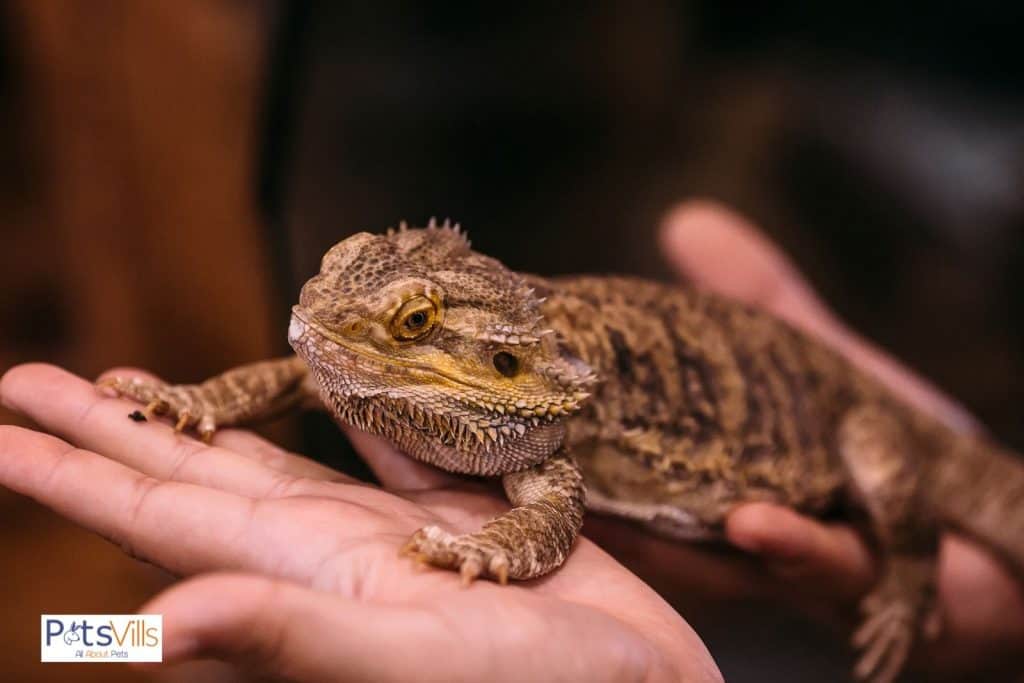
Bearded dragons don’t need much water, so don’t overdo the misting. Most lizards do fine with one-two tablespoons of water per day.
And too much hydration can lead to diarrhea and raise the humidity in the enclosure to dangerous levels.
To determine how much misting your beardie needs, you should keep an eye for signs of dehydration, such as sunken eyes, loss of appetite, thick saliva, constipation, and wrinkled skin.
Misting Bearded Dragons: FAQs
How Do I Keep My Bearded Dragon Hydrated?
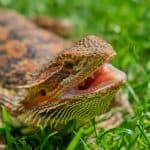
To keep your bearded lizard hydrated, you need to use a combination of hydration techniques – proper diet, bathing, and misting. But you should also provide a water bowl so that your beardie can drink when thirsty.
Do Bearded Dragons Need a Humidifier?
The ideal humidity level for a bearded dragon is between 30% and 40%. If the humidity in your house is too low, you can consider a humidifier, but there are other easy ways to raise the moisture in the air.
Do Bearded Dragons Absorb Water Through the Skin?
No, bearded dragons can’t absorb water through the skin. But they can drink water through their vent – the opening near the tail from where your lizard urinates and defecates.
Can I Bathe My Bearded Dragon in Tap Water?
You can bathe your bearded dragon in tap water as long as it’s chlorine-free and doesn’t contain any chemicals. But it’s better to use filtered water since many beardies like drinking the bath water.
How Much Do You Mist Your Bearded Dragon?
You should spray your bearded lizards until water droplets form on the head. Don’t drench your pet in water because it can lead to aspiration.
Conclusion
Misting bearded dragons is a great way to maintain proper hydration levels when your lizard is reluctant to drink from a water bowl. It also speeds up shedding and keeps the scales soft.
However, misting can have a negative impact on your bearded dragon’s health if you raise the tank’s humidity too much. It also won’t help with hydration if your lizard isn’t licking the droplets.
As such, you should carefully monitor your bearded lizards for signs of dehydration, even if you’re misting them on a regular basis.
Resources:
- 1. Bearded dragon CARE SHEET ENVIRONMENT [Internet]. Available from: https://www.rspca.org.uk/documents/1494939/0/Bearded+Dragon+Care+Sheet+%28PDF+350KB%29.pdf/151bb6df-1c35-a484-6de8-bffed4985abf?t=1556100899951
- 2. Misting? [Internet]. Bearded Dragon .org. [cited 2021 Dec 13]. Available from: https://www.beardeddragon.org/threads/misting.143034/
- 3. Millburn N. Are Misters Good for Bearded Dragons? [Internet]. Pets on Mom.com. [cited 2021 Dec 13]. Available from: https://animals.mom.com/misters-good-bearded-dragons-9044.html
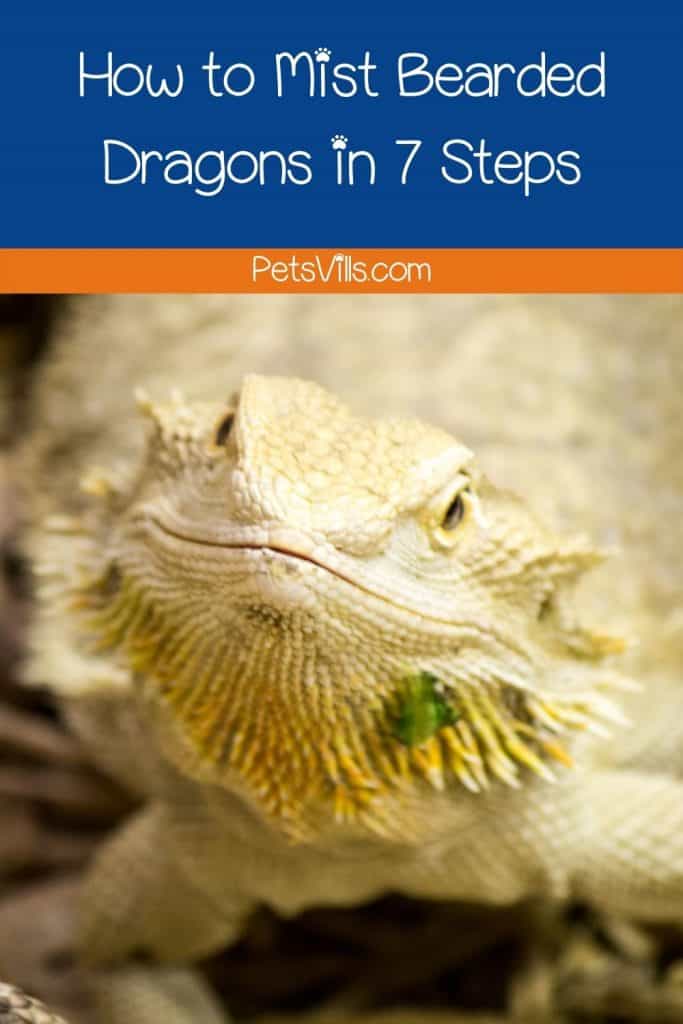
What do you think about misting bearded dragons? Are you pro-misting or anti-misting? Share your opinion in the comment section.
Grigorina grew up surrounded by animals – dogs, cats, cows, goats, sheep, and horses and that has shaped her into what I am today – a crazy cat lady who always has a place for one more cat (or a dog). She has two female cats – Kitty and Roni, and two tomcats – Blacky and Shaggy, but she also feeds her neighbors’ cats when they come for a visit. I just can’t say no to them. Follow her on FACEBOOK AND INSTAGRAM
Read her latest articles HERE
Learn more about her

